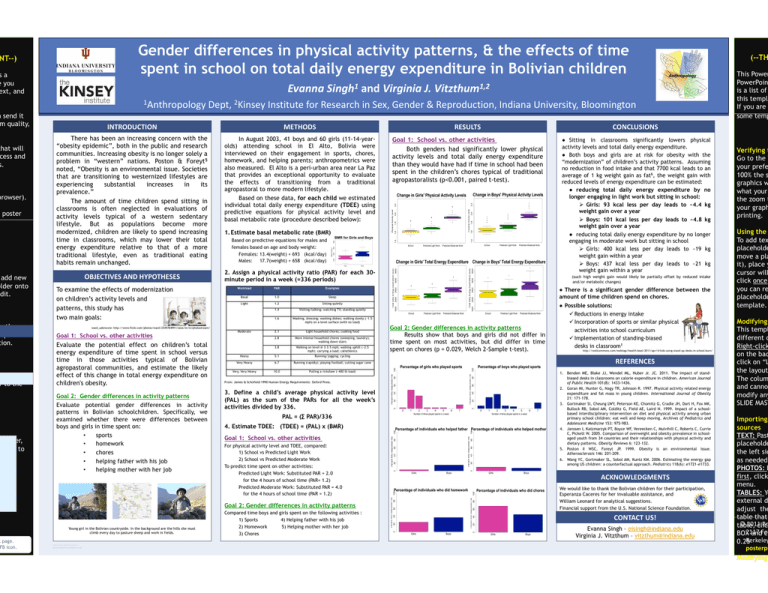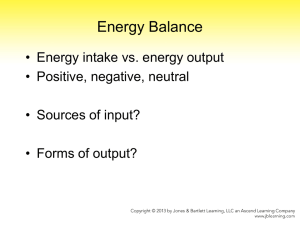QUICK DESIGN GUIDE
advertisement

Gender differences in physical activity patterns, & the effects of time spent in school on total daily energy expenditure in Bolivian children NT--) sa e you ext, and browser). d poster add new older onto edit. nother separate tion. r to the r poster, cture to k page. FB icon. Anthropology Evanna Singh1 and Virginia J. Vitzthum1,2 1Anthropology Dept, 2Kinsey Institute for Research in Sex, Gender & Reproduction, Indiana University, Bloomington n send it m quality, that will cess and s. (--TH INTRODUCTION METHODS RESULTS CONCLUSIONS There has been an increasing concern with the “obesity epidemic”, both in the public and research communities. Increasing obesity is no longer solely a problem in “western” nations. Poston & Foreyt5 noted, “Obesity is an environmental issue. Societies that are transitioning to westernized lifestyles are experiencing substantial increases in its prevalence.” The amount of time children spend sitting in classrooms is often neglected in evaluations of activity levels typical of a western sedentary lifestyle. But as populations become more modernized, children are likely to spend increasing time in classrooms, which may lower their total energy expenditure relative to that of a more traditional lifestyle, even as traditional eating habits remain unchanged. In August 2003, 41 boys and 60 girls (11-14-yearolds) attending school in El Alto, Bolivia were interviewed on their engagement in sports, chores, homework, and helping parents; anthropometrics were also measured. El Alto is a peri-urban area near La Paz that provides an exceptional opportunity to evaluate the effects of transitioning from a traditional agropastoral to more modern lifestyle. Based on these data, for each child we estimated individual total daily energy expenditure (TDEE) using predictive equations for physical activity level and basal metabolic rate (procedure described below): Goal 1: School vs. other activities Both genders had significantly lower physical activity levels and total daily energy expenditure than they would have had if time in school had been spent in the children’s chores typical of traditional agropastoralists (p<0.001, paired t-test). ● Sitting in classrooms significantly lowers physical activity levels and total daily energy expenditure. ● Both boys and girls are at risk for obesity with the “modernization” of children’s activity patterns. Assuming no reduction in food intake and that 7700 kcal leads to an average of 1 kg weight gain as fat6, the weight gain with reduced levels of energy expenditure can be estimated: ● reducing total daily energy expenditure by no longer engaging in light work but sitting in school: Girls: 93 kcal less per day leads to ~4.4 kg weight gain over a year Boys: 101 kcal less per day leads to ~4.8 kg weight gain over a year ● reducing total daily energy expenditure by no longer engaging in moderate work but sitting in school Girls: 400 kcal less per day leads to ~19 kg weight gain within a year Boys: 437 kcal less per day leads to ~21 kg weight gain within a year OBJECTIVES AND HYPOTHESES To examine the effects of modernization on children’s activity levels and patterns, this study has two main goals: 1. Estimate basal metabolic rate (BMR) Based on predictive equations for males and females based on age and body weight: Females: 13.4(weight) + 693 (kcal/day) Males: 17.7(weight) + 658 (kcal/day) 2. Assign a physical activity ratio (PAR) for each 30minute period in a week (=336 periods) Workload PAR Basal 1.0 Sleep Light 1.2 Sitting quietly 1.4 Visiting/talking; watching TV; standing quietly 1.6 Washing, dressing; washing dishes; walking slowly (~1.5 mph) on a level surface (with no load) 2.1 Light household chores; cooking food 2.8 More intense household chores (sweeping, laundry); walking down stairs 3.8 Walking on level @ 3-3.5 mph; walking uphill (~2.5 mph); carrying a load; calisthenics wasil_uderscore: http://www.flickr.com/photos/waxil/2549784991/sizes/m/in/photostream/ Goal 1: School vs. other activities Evaluate the potential effect on children’s total energy expenditure of time spent in school versus time in those activities typical of Bolivian agropastoral communities, and estimate the likely effect of this change in total energy expenditure on children's obesity. Goal 2: Gender differences in activity patterns Evaluate potential gender differences in activity patterns in Bolivian schoolchildren. Specifically, we examined whether there were differences between boys and girls in time spent on: • sports • homework • chores • helping father with his job • helping mother with her job Moderate Heavy 5.1 Running/jogging; cycling Very Heavy 6.7 Running (rapidly); playing football; cutting sugar cane Very, Very Heavy 10.0 Pulling a rickshaw (~400 lb load) From: James & Schofield 1990 Human Energy Requirements: Oxford Press. 3. Define a child’s average physical activity level (PAL) as the sum of the PARs for all the week’s activities divided by 336. PAL = (∑ PAR)/336 4. Estimate TDEE: (TDEE) = (PAL) x (BMR) Goal 1: School vs. other activities For physical activity level and TDEE, compared: 1) School vs Predicted Light Work 2) School vs Predicted Moderate Work To predict time spent on other activities: Predicted Light Work: Substituted PAR = 2.0 for the 4 hours of school time (PAR= 1.2) Predicted Moderate Work: Substituted PAR = 4.0 for the 4 hours of school time (PAR = 1.2) Goal 2: Gender differences in activity patterns Young girl in the Bolivian countryside. In the background are the hills she must climb every day to pasture sheep and work in fields. RESEARCH POSTER PRESENTATION DESIGN © 2011 www.PosterPresentations.com (such high weight gain would likely be partially offset by reduced intake and/or metabolic changes) Examples Compared time boys and girls spent on the following activities : 1) Sports 4) Helping father with his job 2) Homework 5) Helping mother with her job 3) Chores ● There is a significant gender difference between the amount of time children spend on chores. Goal 2: Gender differences in activity patterns Results show that boys and girls did not differ in time spent on most activities, but did differ in time spent on chores (p = 0.029, Welch 2-Sample t-test). ● Possible solutions: Reductions in energy intake Incorporation of sports or similar physical activities into school curriculum Implementation of standing-biased desks in classroom1 http://wellcommons.com/weblogs/health-beat/2011/apr/4/kids-using-stand-up-desks-in-school-burn/ REFERENCES 1. Benden ME, Blake JJ, Wendel ML, Huber Jr. JC. 2011. The impact of standbiased desks in classrooms on calorie expenditure in children. American Journal of Public Health 101(8): 1433-1436. 2. Goran MI, Hunter G, Nagy TR, Johnson R. 1997. Physical activity related energy expenditure and fat mass in young children. International Journal of Obesity 21: 171-178. 3. Gortmaker Sl, Cheung LWY, Peterson KE, Chomitz G, Cradle JH, Dart H, Fox MK, Bullock RB, Sobol AM, Colditz G, Field AE, Laird N. 1999. Impact of a schoolbased interdisciplinary intervention on diet and physical activity among urban primary school children: eat well and keep moving. Archives of Pediatrics and Adolescent Medicine 153: 975-983. 4. Janssen I, Katzmarzyk PT, Boyce WF, Vereecken C, Mulvihill C, Roberts C, Currie C, Pickett W. 2005. Comparison of overweight and obesity prevalence in schoolaged youth from 34 countries and their relationships with physical activity and dietary patterns. Obesity Reviews 6: 123–132. 5. Poston II WSC, Foreyt JP. 1999. Obesity is an environmental issue. Atherosclerosis 146: 201-209. 6. Wang YC, Gortmaker SL, Sobol AM, Kuntz KM. 2006. Estimating the energy gap among US children: a counterfactual approach. Pediatrics 118(6): e1721-e1733. ACKNOWLEDGMENTS We would like to thank the Bolivian children for their participation, Esperanza Caceres for her invaluable assistance, and William Leonard for analytical suggestions. Financial support from the U.S. National Science Foundation. CONTACT US! Evanna Singh – eisingh@indiana.edu Virginia J. Vitzthum – vitzthum@indiana.edu This Power PowerPoin is a list of this templ If you are some temp Verifying t Go to the your prefe 100% the s graphics w what your the zoom t your graph printing. Using the To add tex placeholde move a pla it), place y cursor will click once you can re placeholde template. Modifying This templ different c Right-click on the bac click on “L the layout The colum and canno modify any SLIDE MAST Importing sources TEXT: Past placeholde the left sid as needed PHOTOS: D first, click menu. TABLES: Yo external d adjust the table that © 2011 Po table, clic 2117 Fo BOX and c Berkeley 0.25 posterpr Modifying To change to the “De can choose or you can




